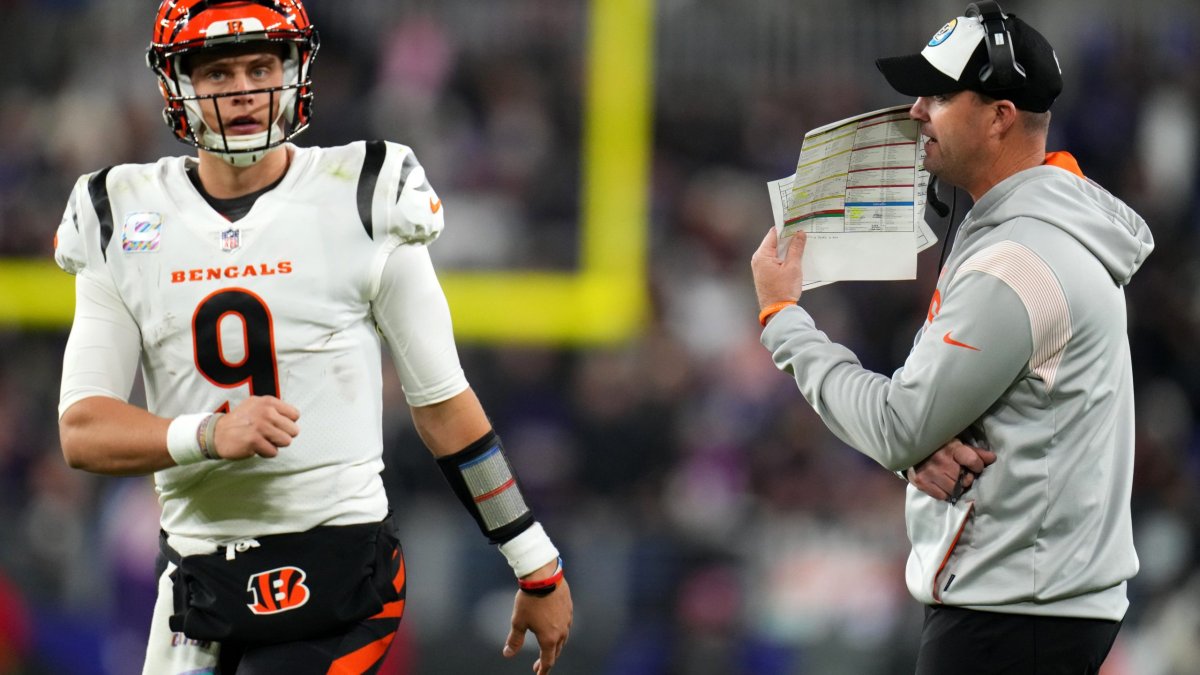Sixteenth in points per game (21.6). Fifteenth in points per drive (1.88). Eighteenth in expected points added per play (-.051).
The Cincinnati Bengals have turned what was the league’s most exciting collection of young skill talent a year ago — quarterback Joe Burrow, wide receivers Ja’Marr Chase, Tee Higgins and Tyler Boyd, and running back Joe Mixon — into a rank-average offense. And the worrisome part, when you dig into the tape and the numbers, is that there are not a lot of missed opportunities to point to where Cincinnati can improve.
Between a combination of their offensive line woes and stubborn play calling, the Bengals may just be an average offense in 2022.
Joe Burrow
Burrow has obviously been putting the ball in harm's way far more often in 2022 than a season ago. His turnover-worthy play rate has nearly doubled, from 2.1% in 2021 to 3.8% this season. That has a large correlation to both problems we’ll see below.
While he’s been much maligned for holding onto the football, that was also the case last season. Burrow’s 28.1% pressure-to-sack conversion rate is right in line with his 26.9% rate from 2021. It’s just that there have been no big-time throws to make up for the sacks. His 2.5% big-time throw rate is a far cry from his 6.4% mark last year. As far as issues with the Bengals offense go, Burrow’s poor numbers feel more like a symptom when watching the tape rather than a root cause.
Offensive Line
The Bengals laid out over $70 million in per-year contract value to three different starters along their offensive line, only to see the exact same results from a season ago. They earned a 56.9 pass-blocking grade during the regular season in 2021. And now through five games in 2022, they’re at 58.9.
The primary cause for concern is that the upgrade they thought they were getting at right tackle has turned out to be their biggest liability. La’el Collins’ 43.9 pass-blocking grade is the fourth-lowest of any starting tackle in the NFL and the lowest of any tackle who was supposed to be starting prior to the season. His career track record is far better than that, but with his injury history, it’s worth wondering if Cincinnati paid for a lemon at this point. If that’s the case, this line won't be turning things around any time soon.
Play Calling
This is still the biggest reason that the Bengals have flat-out failed to adjust their offense in numerous ways this season. They’re not giving enough help to an overmatched offensive line, pounding a putrid running game in unfavorable situations and still running verticals into two-high safeties.
The latter point is the hardest to ignore. The Bengals offense has been brought to its knees by two-high shells in 2022. On 150 snaps against some variation of two-high coverage (Cover 2, Cover 2 man, quarters, Cover 6), the Cincinnati offense has averaged -.104 EPA per play. And that’s with them picking up 185 yards on 39 rushes (.123 EPA per rush) against those shells.
Burrow against two-high coverages in 2022
| Dropbacks | 118 |
| Sacks | 14 |
| Completions | 67 |
| Attempts | 97 |
| Comp % | 69.1% |
| Yards | 602 |
| YPA | 6.2 |
| TDs | 1 |
| INTs | 5 |
| Big-Time Throws | 0 |
| Turnover-Worthy Plays | 7 |
| Average Depth of Target | 6.1 |
| PFF Passing Grade | 50.3 |
It’s almost comical how Cincinnati’s offense has had no way of generating big plays against two deep safeties. They've tallied only 11 explosive pass plays (15-plus yard gains) on 118 such dropbacks compared to 16 explosive pass plays on only 106 dropbacks against single high. Defenses have taken the go-ball away, and head coach Zac Taylor hasn’t found a way to respond. Until the above chart changes, defenses will only live in two-high more against this Bengals offense and watch the unit try to crawl downfield.




 © 2025 PFF - all rights reserved.
© 2025 PFF - all rights reserved.